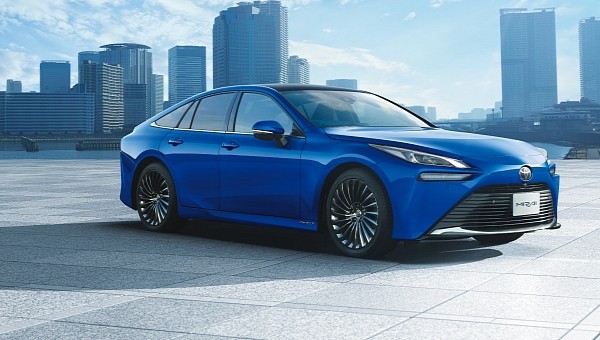Series-production hydrogen vehicles have never been affordable. GM is credited with having developed the first fuel-cell road car, the 1966 Electrovan, which was nipped in the bud after only a single unit was built. Closer to the present, in 2013, Hyundai launched the Tucson Fuel Cell in limited numbers at $499 per month for 36 months with $3,000 down.
The South Korean automaker continues to sell FCEVs in the United States and beyond. The Nexo crossover, which is pretty similar in dimensions to the current-generation Tucson, costs a simply ridiculous $59,435 sans destination charge. It’s only available at select dealers in California to boot, which defeats the purpose of mass adoption of the new technology.
Toyota is a hydrogen believer as well, although the Mirai for the U.S. market is only available in California. Slightly more affordable than the Nexo at $49,500 sans destination and extras, the mid-size sedan is considerably more expensive than its closest fossil-fuel equivalent from the same automaker. More specifically, the good ol’ Camry starts at $25,945 for the LE trim level and tops $36,360 for the V6-engined XSE.
Over in Japan, the country with the largest number of hydrogen refueling stations in the world, the Mirai has been updated for the 2023 model year. But first, have a wild guess of how much it costs, given that Toyota produces it locally. No fewer than seven choices are listed by the online configurator, with prices ranging between 7,106,000 and 8,600,000 yen.
Converted at current exchange rates, that means 53,470 and 64,710 freedom eagles. What kind of updates have been made for the 2023 model year in the Mirai’s home market? For starters, Display Audio Plus touchscreen infotainment is now standard. Equipped with satellite navigation as standard, the Mirai rocks a landscape-oriented touchscreen.
Wi-Fi hotspot is also listed as new, along with better insulation up front. Finally, the last piece of the puzzle is the Toyota Teammate suite of advanced driver-assistance technologies. The Advanced Drive functionality has a bit of a problem, though, a problem shared with the semi-autonomous driving systems currently offered by other automakers.
Last updated in October 2022, the interactive map where that shows where Advanced Drive can be used in Japan lists only highways and expressways. Not all of them, as expected. The system also leaves much to be desired as opposed to the Full Self-Driving upgrade offered by Tesla.
Rated at 152 kilometers (94.4 miles) per kilogram (2.2 pounds) of hydrogen as per WLTC testing procedures, the Mirai’s range drops from the Z specification upward. Capable of 175 kilometers per hour (109 miles per hour) on full song, the zero-emission sedan weighs between 1,920 and 1,990 kilograms (4,233 and 4,387 pounds), depending on the trim level.
Toyota is a hydrogen believer as well, although the Mirai for the U.S. market is only available in California. Slightly more affordable than the Nexo at $49,500 sans destination and extras, the mid-size sedan is considerably more expensive than its closest fossil-fuel equivalent from the same automaker. More specifically, the good ol’ Camry starts at $25,945 for the LE trim level and tops $36,360 for the V6-engined XSE.
Over in Japan, the country with the largest number of hydrogen refueling stations in the world, the Mirai has been updated for the 2023 model year. But first, have a wild guess of how much it costs, given that Toyota produces it locally. No fewer than seven choices are listed by the online configurator, with prices ranging between 7,106,000 and 8,600,000 yen.
Converted at current exchange rates, that means 53,470 and 64,710 freedom eagles. What kind of updates have been made for the 2023 model year in the Mirai’s home market? For starters, Display Audio Plus touchscreen infotainment is now standard. Equipped with satellite navigation as standard, the Mirai rocks a landscape-oriented touchscreen.
Wi-Fi hotspot is also listed as new, along with better insulation up front. Finally, the last piece of the puzzle is the Toyota Teammate suite of advanced driver-assistance technologies. The Advanced Drive functionality has a bit of a problem, though, a problem shared with the semi-autonomous driving systems currently offered by other automakers.
Last updated in October 2022, the interactive map where that shows where Advanced Drive can be used in Japan lists only highways and expressways. Not all of them, as expected. The system also leaves much to be desired as opposed to the Full Self-Driving upgrade offered by Tesla.
Rated at 152 kilometers (94.4 miles) per kilogram (2.2 pounds) of hydrogen as per WLTC testing procedures, the Mirai’s range drops from the Z specification upward. Capable of 175 kilometers per hour (109 miles per hour) on full song, the zero-emission sedan weighs between 1,920 and 1,990 kilograms (4,233 and 4,387 pounds), depending on the trim level.






